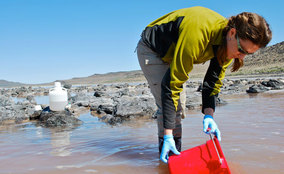Seattle Times: Cool Jobs Featuring ISB Scientist Karlyn Beer
 isbscience.org/news/2012/06/13/seattle-times-cool-jobs-featuring-isb-scientist-karlyn-beer/
isbscience.org/news/2012/06/13/seattle-times-cool-jobs-featuring-isb-scientist-karlyn-beer/
Karlyn Beer, one of our grad students who works in Nitin Baliga's Lab, was featured in the Seattle Times' "Cool Jobs" section. An excerpt is below. See the full story here.
What do you do? I'm a Ph.D. student at the University of Washington, and I work at Institute for Systems Biology, studying how microbes navigate their way through complicated and ever-changing environments
I work with a single-celled organism native to hypersaline habitats like the Great Salt Lake (10 times saltier than the ocean!). The Great Salt Lake is a tough place to be a microbe because of its high salt, low oxygen and broad swings in temperature and UV radiation.
These microbes also make great models for understanding adaptation in other harsh environments, like the insides of our intestines or the surface of Mars.
What's a typical day like? No day is typical. Sometimes I'm in the lab all day, sometimes I'm busy analyzing data. Every few months I spend time writing or preparing to give a talk, and once I got to visit the Great Salt Lake to collect water and cell samples.
How does someone get a job like yours? Like science, be a little stubborn, and be OK telling your parents you're 28 and still not done with school.






